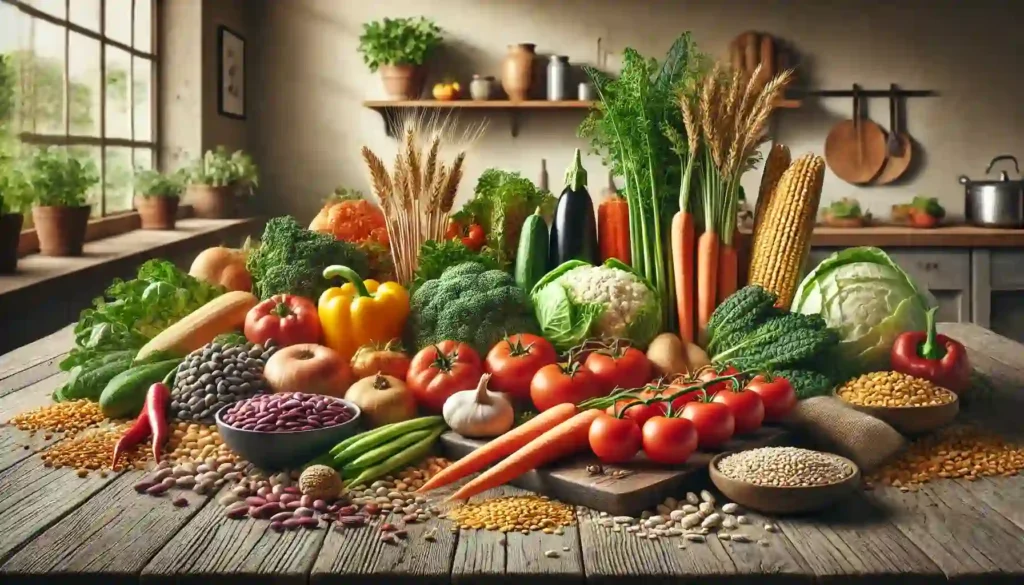As the world becomes increasingly aware of climate change, the concept of a carbon-neutral diet has emerged as a way to reduce individual and collective environmental impact. By making mindful food choices, we can significantly lower our carbon footprint, support sustainable farming practices, and contribute to a healthier planet. Here’s how to adopt a carbon-neutral diet and make sustainable eating a part of your everyday life.
“We don’t need a handful of people doing zero waste perfectly. We need millions of people doing it imperfectly.” – Anne-Marie Bonneau, Zero Waste Chef
What is a Carbon-Neutral Diet?

A carbon-neutral diet focuses on minimizing the carbon emissions associated with food production, transportation, and consumption. The goal is to balance the carbon footprint of your diet by choosing foods that have lower environmental impacts and, when possible, offsetting any remaining emissions through sustainable practices.
Key Principles
- Local and Seasonal Eating: Prioritize foods that are locally grown and in season, reducing the carbon emissions from transportation and storage.
- Plant-Based Choices: Plant-based foods generally have a lower carbon footprint than animal products, making them a central component of a carbon-neutral diet.
- Minimizing Food Waste: Reducing food waste is essential for lowering your overall carbon footprint. Plan meals carefully and use leftovers creatively.
- Sustainable Sourcing: Choose foods from suppliers and farmers who prioritize sustainable and regenerative agricultural practices.
How to Adopt a Carbon-Neutral Diet
Transitioning to a carbon-neutral diet involves making conscious choices about what you eat and where your food comes from. Here are some steps to get started.
Choose Plant-Based Foods
One of the most effective ways to reduce your carbon footprint is to increase the proportion of plant-based foods in your diet.
- Meat Alternatives: Substitute meat with plant-based proteins such as beans, lentils, tofu, and tempeh.
- Vegetable-Rich Meals: Create meals centered around vegetables, grains, and legumes, which have lower carbon footprints compared to meat and dairy.
- Sustainable Proteins: If you do consume animal products, opt for sustainably sourced fish or poultry, which have a lower carbon footprint than red meat.
Support Local and Organic Farmers
Eating locally produced and organic food reduces the environmental impact of transportation and supports sustainable farming practices.
- Farmers’ Markets: Shop at farmers’ markets to buy fresh, seasonal produce directly from local growers.
- Community Supported Agriculture (CSA): Join a CSA program to receive regular deliveries of local, organic produce.
- Organic Choices: When possible, choose organic foods that are grown without synthetic pesticides and fertilizers, which contribute to soil health and biodiversity.
Reduce Food Waste
Minimizing food waste is a critical component of a carbon-neutral diet.
- Meal Planning: Plan your meals in advance to buy only what you need, reducing the likelihood of food spoiling.
- Leftovers: Use leftovers creatively in new dishes or freeze them for later use.
- Composting: Compost food scraps to return nutrients to the soil and reduce methane emissions from landfills.
Opt for Sustainable Seafood
When eating seafood, choose options that are sustainably sourced to protect marine ecosystems.
- Sustainable Labels: Look for certifications like the Marine Stewardship Council (MSC) label, which indicates that the seafood was caught sustainably.
- Diverse Choices: Opt for lesser-known, sustainable fish species to reduce pressure on overfished populations.
- Local Seafood: Whenever possible, choose locally sourced seafood to reduce the carbon footprint associated with transportation.
The Benefits of a Carbon-Neutral Diet
Adopting a carbon-neutral diet offers numerous benefits, not only for the environment but also for your health and the economy.
Environmental Benefits
- Reduced Greenhouse Gas Emissions: By choosing foods with lower carbon footprints, you can significantly reduce the greenhouse gases associated with your diet.
- Soil and Water Conservation: Sustainable farming practices promoted by a carbon-neutral diet help conserve soil and water resources.
- Biodiversity Preservation: Supporting organic and regenerative agriculture helps maintain biodiversity and protect ecosystems.
Health Benefits
- Improved Nutrition: A diet rich in plant-based foods provides essential nutrients and can reduce the risk of chronic diseases.
- Lower Exposure to Toxins: Choosing organic foods reduces your exposure to synthetic pesticides and fertilizers.
- Balanced Diet: A carbon-neutral diet encourages a balanced intake of various food groups, promoting overall health and well-being.
Economic and Social Benefits
- Support for Local Economies: Buying locally produced food supports small farmers and local economies.
- Food Security: Sustainable farming practices contribute to long-term food security by preserving the health of agricultural land.
- Ethical Consumption: A carbon-neutral diet aligns with ethical values by promoting fair labor practices and animal welfare.
Practical Tips for Maintaining a Carbon-Neutral Diet
To maintain a carbon-neutral diet, consider these practical tips that can help you stay on track.
Batch Cooking and Meal Prep

Preparing meals in advance can help reduce food waste and ensure you always have healthy, sustainable options on hand.
- Batch Cooking: Cook large quantities of food that can be stored and eaten throughout the week.
- Freezing Meals: Freeze meals in portions to avoid food waste and have convenient, ready-to-eat options.
- Reusable Containers: Store food in reusable containers to minimize waste from single-use packaging.
Grow Your Own Food

Growing your own food can be a rewarding way to reduce your carbon footprint.
- Home Garden: Start a small garden at home to grow herbs, vegetables, and fruits.
- Community Gardens: Join a community garden to share resources and knowledge with others.
- Indoor Plants: Even if space is limited, consider growing herbs or small plants indoors.
Mindful Shopping
Shopping mindfully can help you make more sustainable choices.
- Buy in Bulk: Purchase staples like grains, nuts, and beans in bulk to reduce packaging waste and save money.
- Seasonal Produce: Choose seasonal produce, which is fresher and has a lower carbon footprint.
- Eco-Friendly Packaging: Look for products with minimal or eco-friendly packaging.
The Future of Carbon-Neutral Diets
As more people become aware of the environmental impact of their food choices, carbon-neutral diets are likely to become more popular.
Increasing Accessibility
Efforts to make sustainable food options more accessible and affordable will play a key role in the widespread adoption of carbon-neutral diets.
- Policy Support: Government policies that support sustainable agriculture and reduce food waste will help make carbon-neutral diets more attainable.
- Education and Awareness: Public awareness campaigns can educate people on the benefits of carbon-neutral diets and how to adopt them.
Innovation in Sustainable Food Production
Technological advancements and innovation in food production will continue to improve the sustainability of our food systems.
- Plant-Based Alternatives: The development of new plant-based foods that mimic animal products can make it easier for people to transition to a carbon-neutral diet.
- Regenerative Agriculture: Innovations in regenerative farming practices will enhance soil health and increase the sustainability of crop production.
- Carbon Offsetting: Companies and individuals may increasingly use carbon offsetting to balance the emissions from their diets.
“Eating is an agricultural act.” – Wendell Berry, environmental activist and writer
Top Sustainable Eating Tips offers insights into current and emerging trends in eco-friendly food practices. For more tips on adopting a carbon-neutral diet, visit Carbon-Neutral Eating. Discover additional strategies for sustainable living in our sustainable living section. Learn more about regenerative agriculture with our guide to eco-friendly farming. For more information on sustainable food systems, visit The Good Food Institute. To explore the latest in plant-based diets, check out Veganuary. For additional resources, see Sustainable Agriculture Research & Education (SARE).














